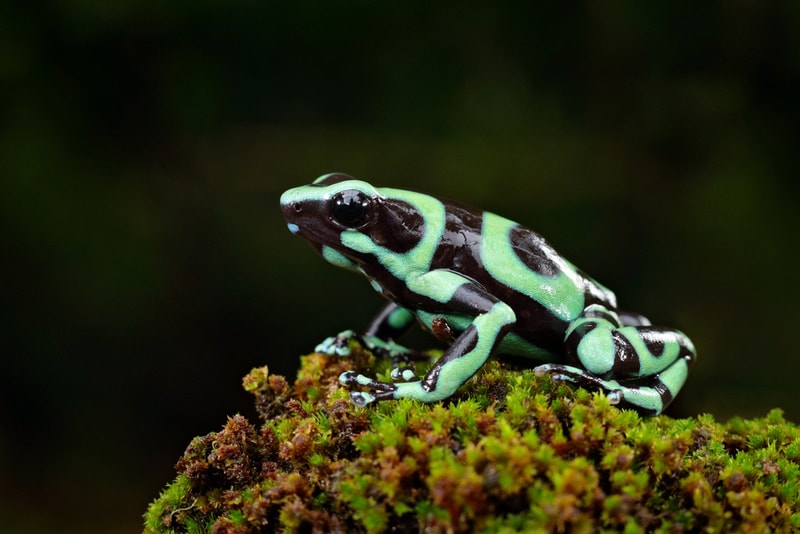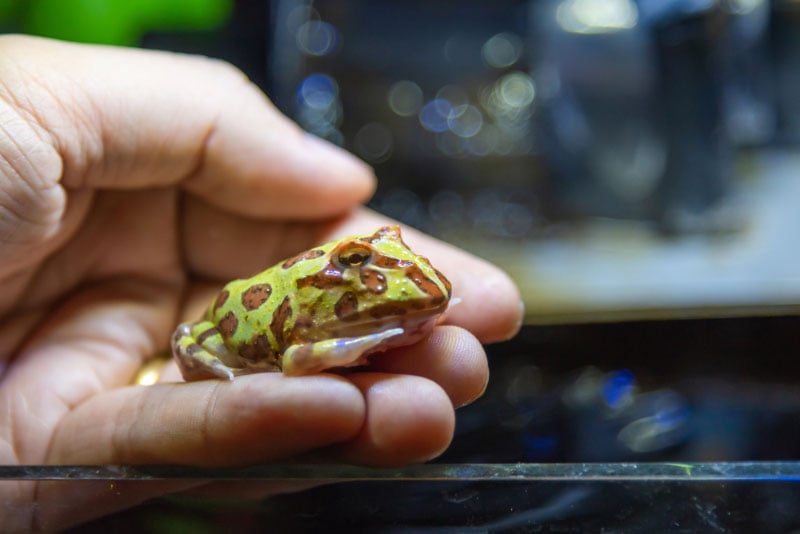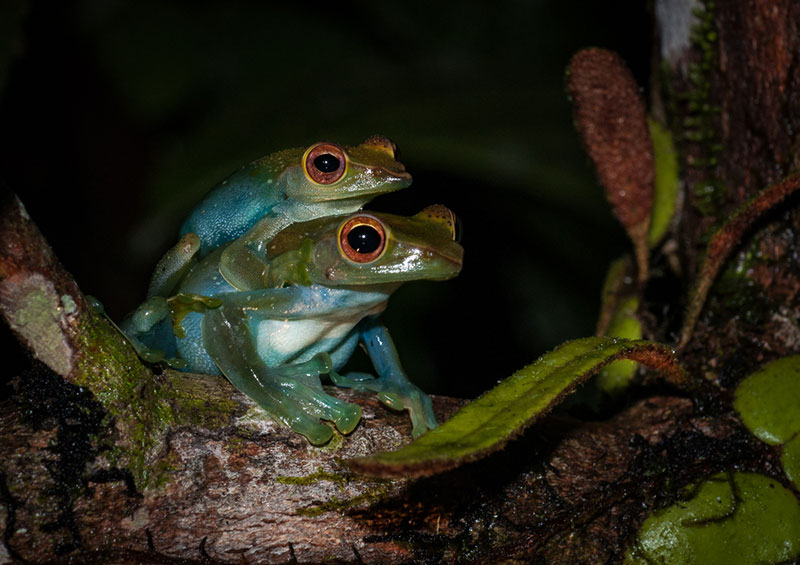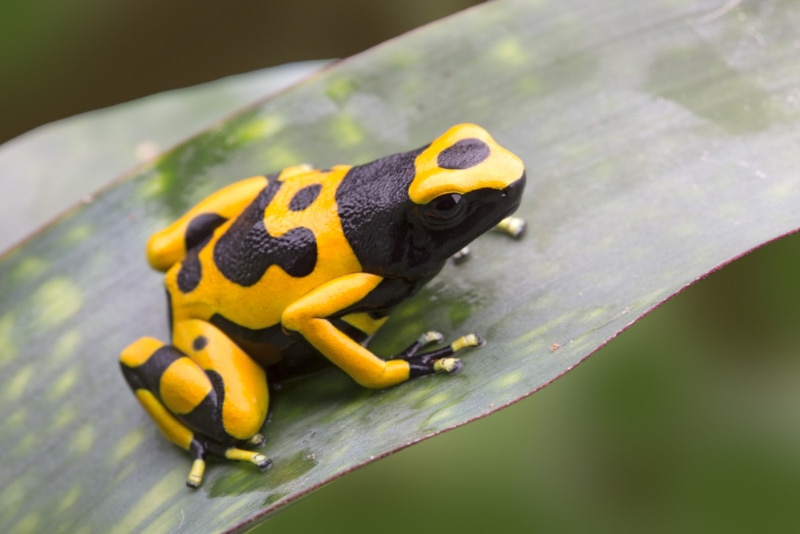Green and Black Poison Dart Frog: Lifespan, Diet, Pictures & Care Guide
Updated on

Click to Skip Ahead
The Green and Black Poison Dart frog is an exquisite little amphibian that can make a very interesting and rewarding pet. They are hardy and relatively easy to take care of. This makes them particularly suitable for first-time frog keepers, yet they are equally enjoyable for expert herpetologists.
Read on to find out more about this diminutive Poison Dart frog that is, justifiably, a favorite pet of many.
Breed Overview
| Size: | 0.75–2 inches |
| Lifespan: | 10+ years |
| Color: | Green and black |
| Suitable for: | Beginner to experienced herpetologists |
| Temperament: | Docile |
| Diet: | Insectivorous |
| Tank Set Up: | Tropical environment |
| Minimum Tank Size: | 10 gallons |
| Suitable Tank Mates: | Other Green and Black Poison Dart Frogs only |
As their name implies, they are a combination of black and a beautiful, almost-iridescent light green, giving them a very eye-catching overall appearance. Their coloration is a warning to all other creatures that messing with them could end badly. Their name says it all. They are poisonous!
Under natural conditions, their skin produces a highly toxic substance powerful enough to stop a human heart. Fortunately, captive-bred Poison Dart frogs lose their toxicity and are completely harmless.
Green and Black Poison Dart Frog Characteristics
Green and Black Poison Dart Frog Overview
The Green and Black Poison Dart Frog (Dendrobates auratus) is indigenous to Central America and some parts of South America. It has also been introduced to Hawaii, and populations have been observed in Maui. In the wild, its numbers are plentiful, and from a conservation standpoint, it has “least concern” status. The Green and Black Poison Dart frog is not even the most toxic of the Dart frogs. That honor belongs to Phyllobates terribilis, the Golden Poison Frog. Native South Americans would coat their arrow tips with their toxins so that their prey would die quickly.
Dart frogs only release their toxins when they are stressed or threatened. Unfortunately, to elicit this response, the unfortunate frogs are roasted over a small fire, and the toxin-harvesting process ultimately results in their demise.
Green and Black Poison Dart Frogs are tropical and sub-tropical semi-arboreal species. They spend part of their lives in trees. However, they cannot jump between trees, and to travel around, they need to climb out of the tree and move across the ground to the next tree. They usually live in trees and the damp leaf litter on the ground near a stream or other body of water.

Green and Black Poison Dart Frog Cost?
Green and Black Poison Dart Frogs are definitely exotic, but they’re not rare. They breed readily, and captive-bred frogs are widely available.
An adult, captive-bred Green and Black Poison Dart frog will cost anywhere from $30 to $80. The price depends on the individual’s size, age, health, and coloration.
Care Guide & Tank Set Up
A Green and Black Poison Dart Frog’s tank set-up is vitally important. Remember that they will spend 100% of their time in their tank. It is going to be their exclusive living habitat. There will be little to no need to take them out, except perhaps when conducting a deep clean. Dart frogs don’t enjoy being handled, and it’s not good for them.
Tank Size
A single Dart frog can live happily in a 10-gallon terrarium, but more space is always better. As a rule of thumb, add 10 gallons per additional frog.
Substrate
The ideal flooring for your dart frog’s terrarium should be layered, starting with a drainage layer, then a mesh separation, then soil, spag moss, and leaf litter. These substrates retain moisture and support the plants living in the tank. Some pieces of driftwood and smooth rocks or stones can also be added. The frogs will also appreciate any other little hides that can be included in their tank décor. Avoid the use of peat moss since it’s too acidic for frogs.
Their terrarium should contain an abundance of suitable live plants. Appropriate plants include ferns, bromeliads, and other tropical and air plants.

Humidity
Humidity levels in your Dart Frogs terrarium must remain between 80 and 100%. The closer to 100%, the better. It’s a careful balance to keep the humidity as high as possible without completely saturating the substrate.
Once you get the hang of it, it’s easily achieved. The optimum humidity is obtained through a careful balance of moisture and heat. It is advisable to have a constant humidity reading available using a tank-mounted hygrometer.
Lighting
The frogs require nothing more than ordinary light during daylight hours. This can come from a fluorescent terrarium light, and it’s best if it’s set on a 12-hour day/night cycle, which mimics their natural environment. A terrarium light is also required to support the plant life inside your dart frog’s tank.
Heating
A Green and Black Poison Dart Frog’s terrarium should remain a steady 70 to 80 degrees Fahrenheit. They can tolerate temperatures in the 60s and even colder for short periods. On the other end of the scale, however, temperatures of 85 degrees Fahrenheit and higher can kill them surprisingly quickly. The temperature should be consistently monitored in the same way that humidity is, with a tank-mounted thermometer. There are compact combo units available that record both.
Overhead lamps should not deliver the heat since they will reduce the humidity level in the terrarium. Warm air holds more water vapor, but overhead lamps will evaporate water in the air. The most effective way to regulate the terrarium’s temperature is with a heating pad.

Things to Know When Owning a Green and Black Poison Dart Frog:
Once your tank is set up and your frog, or frogs, are happily installed, the next task to master is how to provide them with the highest level of ongoing care. This includes feeding them, as well as monitoring them for appropriate development and potential illness or injury.
Food & Diet Requirements
Green and Black Poison Dart Frogs are strict insectivores. Fruit flies (flightless) are a great offering, as are pinhead crickets, aphids, small fly larvae, bean and rice flour beetles, and springtails. Care should be taken not to overfeed your frog. As a rule of thumb, no more than what they can eat in 2 minutes is enough.
Juvenile frogs should be fed daily, but adults should only be fed every second or third day. As much as possible, their diet should be varied to mimic what it would be in the wild. Feeder insects can be nutrient-deficient, so it’s advisable to dust them with a nutrient powder before offering them to your frogs.
Water/ Liquid Requirements
The Green and Black Poison Dart Frog requires a moist, tropical habitat. However, as a semi-arboreal species, they don’t spend any time in water. Like all other frog species, they do not drink water but absorb it through their skin.
It’s important to dechlorinate the water and remove harmful heavy metals and other chemicals.
Dart Frogs can swim but not very well, so avoid adding a bowl of water to their terrarium.
Size & Growth Rate
Green and Black Poison Dart Frog’s eggs develop into tadpoles about 2 weeks after being laid. The female frog lays the eggs on the ground in the leaf litter. Once the tadpole emerges, the male carries them up into the trees, where they will continue to develop in small water bodies found in the various nooks and crevices of the canopy.
The tadpoles take 2 to 4 months to metamorphose into adults. The tiny Dart frogs grow steadily and reach their full adult size by the time they are a year old.

Varieties
The Green and Black Poison Dart Frog varies only in its coloration. There are at least eight morphs of this frog. Although it is not known exactly what causes the different morphs, it is thought that the geographic distribution may play a role.
The green part of their coloration can be varying shades of darker green, emerald green, turquoise, pale yellow, or even cobalt blue. The dark color, often black, can also be a dark to wood-colored brown.
Lifespan and Health Conditions
Green and Black Poison Dart Frogs are generally healthy little creatures. They also usually live relatively long and happy lives, giving you more years of enjoyment. You are bound to become very attached to your little frog during the 10 years they are your companion.
There are very few health conditions that are likely to crop up during your time together. Nevertheless, it is a good idea to be informed. If you notice that your frog’s behavior or appearance has altered, it is always a good idea to make an appointment with your veterinarian. Have a look at some of these conditions below:
- Stress
- Injuries
- Parasites
- Red Leg Syndrome
- Chytridiomycosis
- Chromomycosis
- Spindly Leg Syndrome
- Viruses
Male vs Female
The male Green and Black Poison Dart Frog is smaller than the female. He will be slimmer and, on average, about an inch long, while she will be slightly more substantial and an inch and a half long, more or less.
The frogs are best kept in pairs, but if a group of frogs are being kept together, it is advisable to have only males or one female in the group. Females can become aggressive with one another when competing for a male’s attention.
3 Little-Known Facts About Green and Black Poison Dart Frogs
1. Captive-Bred Green and Black Poison Dart Frogs Are Not Poisonous
The toxin secreted by Poison Dart frogs’ skin is synthesized from the frogs’ natural diet of ants, mites, and millipedes in the wild. These insects feed on various plants and fungi found exclusively in the rainforest. In captivity, the Green and Black Poison Dart Frog’s feeder insect diet does not contain the necessary chemicals for them to produce the toxic alkaloid.
2. Wild-Caught Green and Black Poison Dart Frogs Kept in Captivity Might Still Be Poisonous!
It is not advisable to pick up a wild Green and Black Poison Dart Frog or one caught in the wild and now living in domestic conditions. This is because it has been observed that the wild-caught Green and Black Poison Dart Frogs may remain toxic for up to 2 years after they are removed from their natural habitat.
3. They Shouldn’t Be Handled
Dart frogs should be handled as little as possible. This is not because of any toxic threat they may pose to the handler but because they have semi-permeable skins that are very sensitive to oils, lotions, and soaps on a human’s hands. They also become stressed if they are handled too much.

Final Thoughts
Green and Black Poison Dart Frogs make fascinating and satisfying pets. Your frog’s terrarium will complement any room in which is placed. The fact that they are so easy to care for is an even greater incentive to share your home with one of these extraordinary amphibians. After the initial investment of the terrarium set-up, they are reasonably cheap pets to look after. These two aspects make them a great choice for beginner frog enthusiasts or those who would love a pet but are on a budget. If you are happy to enjoy their company in a hands-off manner, a Green and Black Poison Dart Frog could be the perfect pet.
Featured Image Credit: Ondrej Prosicky, Shutterstock










